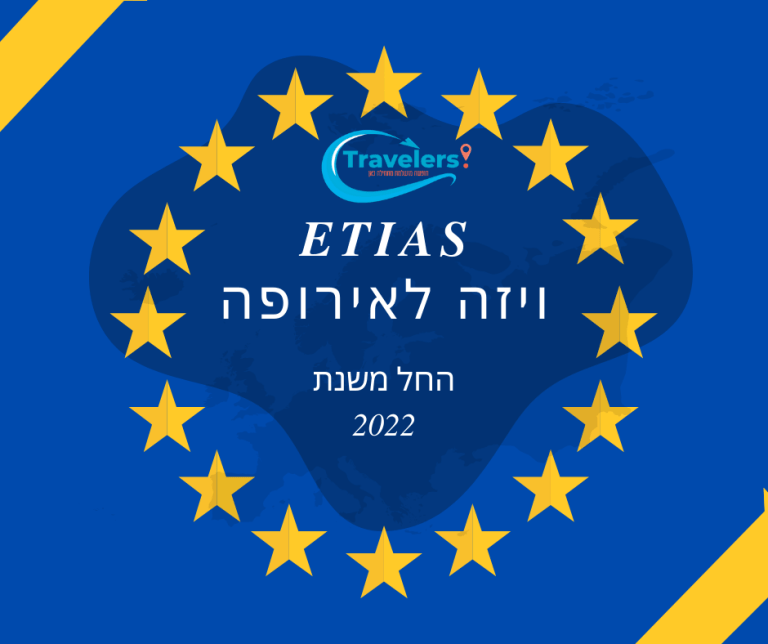Until today, as tourists, we could freely enter the countries of the European Union and most of the countries without any visa, as long as the purpose was for tourism and recreation, but now all that is about to change. Soon Israelis will be required to issue an entry visa before visiting European countries.
There are currently 63 countries that are not in the European Union and there is no limit to entering them without a visa, except that very soon we will need a special permit to enter them. We have prepared a comprehensive article for you in which we will tell you why there was a change, what the purpose of the entry approval is and when the change is expected to take effect.
Today citizens can enter countries in the Schengen area whether it is for business or private purpose up to 90 days. During these 90 days, of course, you are not allowed to work, but you can engage in business activities as long as 3 months have not passed, of course you can travel as a tourist for up to 3 months.
However, in recent years, shocking events have led to security risks as a result of those terrorist events, and there have been more and more voices calling for restricting entry into the European Union countries, in order to prevent a traumatic event etched in the history of the United States, the September 11 disaster. The European Union has decided not to wait for the great disaster to occur in the European countries and for this purpose he decided that restrictions and surveillance should be imposed on each and every person who enters the territory of the EU countries, all this in order to prevent terrorist activity and to make people and tourists personal security.
At the same time, the European Union does not want to create a slow and cumbersome bureaucratic system that will prevent people in today's era from entering Europe, the European Commission (EC) has decided on a solution that will lead to security, without harming the economy and the tourism industry, and this solution is an entry permit - ETIAS.
Let's start by understanding, what is the change that will apply and what is ETIAS?
ETIAS is actually the European Travel Information and Authorization System, a database system that will track all citizens from countries that do not need an entry visa. This has been the practice in the US for years and now Europe will also step in to monitor the people entering its territory.
The procedures to establish the electronic system that will carry out the ETIAS monitoring began in 2016, and it will probably come into force very soon in November 2024.
Through ETIAS they will carry out a thorough security inspection and check on everyone who wants to enter and visit, only after he is found eligible, will he be allowed to enter any country in the Schengen area. The ETIAS will verify that that person does not pose a security threat. This electronic system will contain information containing all personal details, history etc. to determine whether those visitors will be allowed to enter the Schengen countries.
The ETIAS will not only screen people who wish to enter for business or tourism reasons, but also people who wish to enter the Schengen countries because they are awaiting a medical procedure, will also have to go through a security check like everyone else. In addition, it will be mandatory for all countries without a Schengen visa.
Why was it decided that an ETIAS permit was required?
The President of the European Commission, Jean-Claude Juncker, stated in his speech in 2016, as follows:
"We need to know who is crossing our borders. That way we will know who is going to Europe before they even get here."
That is, the main and primary reason for ETIAS approval is security reasons. The European Union wants to ensure regional peace in its countries. The ETIAS will significantly reduce the risk through an electronic system and databases, after all the data about the visitors will be collected and it will be possible to know who is eligible to enter and who is a threat. This means that the ETIAS will identify if a person has a past or background that could harm the security of the Schengen countries. If such a well-founded suspicion is found, an entry restriction will be applied to this person, in order to prevent attacks on the borders of the European Union. That is, instead of putting out fires after terrorist attacks, the goal is to prevent them in advance, it is true that this requires all of us to have a visa, on the other hand we will have a safer feeling to travel, knowing that if we are being monitored, then probably those who pose a threat are also being monitored.
However, the approval of the ETIAS was also created for other reasons, which are not related to security, there were other goals in the EU policy and the considerations are as follows:
- There is a need to establish clear procedures, while shortening the application submission times
- Supervision and management of the borders of the EU countries
- Prevention of crime and terrorism
- Reduce and reduce illegal immigration
- Strengthening the liberal policies of the European Union
The goal is that the approval we will have to receive within the framework of the ETIAS system will be a quick, efficient procedure, so that we do not have to see traveling to the European Union as a cumbersome experience involving trouble.
Which countries will now require an ETIAS entry permit?
These are the European countries that will require an ETIAS entry permit in order to enter them:
Austria, Belgium, Bulgaria, Croatia, Cyprus, Czech Republic, Denmark, Estonia, Finland, France, Germany, Greece, Hungary, Iceland, Italy, Latvia, Liechtenstein, Lithuania, Luxembourg, Malta, Netherlands, Norway, Poland, Portugal, Romania, Slovakia, Slovenia, Spain, Sweden and Switzerland.
Who will need ETIAS?
As mentioned, the ETIAS will require an entry permit for all citizens of countries that can now enter the EU area without a visa. Therefore, the 63 countries that are not in the Union will have to receive the ETIAS approval, for example some of them:
- אלבניה
- אנטיגואה וברבודה
- Argentina
- Australia
- the Bahamas
- Barbados
- Bosnia and Herzegovina
- Brazil
- Brunei
- קנדה
- צ'ילה
- Colombia
- Costa Rica
- Dominica
- El Salvador
- Georgia
- Grenada
- Guatemala
- Honduras
- Hong Kong SAR*
Please note that until the electronic system enters into force and begins to work effectively, many other countries may be added to the same requirements and entry limit, but at the moment, all citizens of the countries listed above will be required to arrange an ETIAS permit if the same visitor wishes to go to any country in the European Union.
How will the ETIAS electronic system and entry permit work?
Those who wish to receive an entry permit will have to submit an application to ETIAS, similar to issuing a visa to the USA:
Filling out the application form
Filling out the ETIAS application is not a long procedure and does not involve more than 10 minutes, personal details, identity number, address, etc. It will be online so you don't have to fill out a lot of paperwork. Depending on the country you want to join, you will have to fill out a form. The information will include the following details:
This biometric information is mandatory for those who want to enter the EU countries:
First name
Last Name
Surname at birth
Date of birth
Place of birth
Information on identity number/citizenship
Address
Email and phone number
Education and work experience
The EU country you intend to visit
Background questions will even include information regarding medical condition and background, travel to countries where war is raging or to places from which you have been deported or denied entry, and a criminal record will be thoroughly checked. That is, if you have applied, you are effectively giving up your privacy and if you have a criminal record and previous convictions, it will be exposed for all to see.
For minors, the legal guardian will apply for ETIAS on their behalf
For family members of EU citizens from other countries, proof of relationship, proof of residence and any other information requested must be presented.
Submitting the application
After completing all the details in the application, a fee must be paid, after which it must be submitted. In order to receive the long-awaited approval, the system checks whether all the data provided to it is as it is, is it not hiding information?
The electronic system checks whether the information you provided is accurate
Your eligibility to enter will be reviewed after your background check
They will check if you are a danger
Only if everything stated in the application form is reliable, you will be eligible for an ETIAS entry permit, the whole procedure is expected to be completed in a short time.
At the same time, some people will not get the approval and will still get another chance to go through an inspection and get the ETIAS approval, the application will be submitted manually. The manual processing is expected to last about 4 days or at most up to two weeks.
How much will it cost to do the inspection process until receiving the ETIAS permit?
The ETIAS is expected to be an expensive procedure. The ETIAS will only cost €7 per application. This only applies to adults over 18, as those under 18 will not be required to pay for entry at all. The fee can be paid by credit card. Immediately after completing the payment, the ETIAS certificate can be an entry permit to the country of your choice.
How long will the ETIAS be valid for?
If approved, the ETIAS may be valid for 3 years or until the expiry of the travel document registered during the application, whichever comes first. Whether you receive the first or second validity period depends on the system's assessment of your information and risk.
Is it possible that your application for ETIAS approval will be rejected?
Yes, the ETIAS application can be rejected for various reasons:
If a person used a travel document that was reported as lost, a stolen identity, i.e. fictitious, you are not the person you claim, if you provided incorrect or illegal details in the application, the Schengen Information System - SIS II should pick up on that.
If it is a person who is a security risk for citizens and travelers of the Schengen area.
The applicant is an illegal immigrant.
The applicant poses a high risk of epidemic.
The applicant has an alert in SIS stating that entry has been refused.
The applicant did not respond to all the requirements, to the request for information within the allotted time or made a mistake or omitted information from the online form.
In addition to all these, the applicant did not come to the interview when needed.
A travel permit may not be granted if there is even a slight doubt about the information provided and the documents that should substantiate the request.
If the ETIAS application is rejected, is there anything to do?
The normal procedure takes a few minutes from the moment you submitted the application, when everything is in order you will receive the answer that you are entitled to your ETIAS entry approval. If not, you will receive the rejection message. In the rejection notice of your application, there will be reasons for the rejection of the ETIAS application. You can appeal this decision, if you have a reason that contradicts the reason for rejection, you can try to submit an application again.
How can I appeal an ETIAS rejection decision?
Any rejected visitor has the right to appeal the decision if he has proof that the decision made regarding him is wrong and caused by mistake. Since a huge amount of people enter the database, there will definitely be mistakes.
The appeal procedures should be handled by the country's ETIAS National Unit, which is responsible for rejecting the application.
What documents are required for an ETIAS entry permit?
In addition to filling out a form with all the information and background regarding education, health and criminal record, you will need to submit your passport for the ETIAS entry visa, if it is valid. Your passport will be checked as follows:
The digital photo is not affixed to the passport
Legible passport, including two lines of numbers, letters and symbols
Electronic passport chip - will be an advantage. This chip can be found on the cover page of the passport at the bottom.
Although the guideline is that only a passport should be submitted for entry approval, be prepared for the fact that the ETIAS application may be conditional on the submission of additional documents.
Who will need to submit additional documents for ETIAS?
When submitting an ETIAS application, if there is a concern about an applicant, he may be asked to submit additional documents, because the ETIAS National Unit of the country you want to enter may think that the information provided by the applicant is insufficient or that additional information is required to check the credibility of the applicant to visit.
The applicant will receive the list of additional documents that he must send by e-mail.
The additional documents must be provided directly to the ETIAS National Unit through the secure account service, within 10 days from the date of receipt of the application.
Can I enter any EU country with an ETIAS permit?
To use an ETIAS entry permit, you must first go through the country you indicated in your application that you want to visit. If you planned to pass through Germany, to Austria for example, and you indicated in your application that the first country you will visit is Germany, you must pass through it before you visit Austria. Once you have entered the first country, you can visit any other country in the Schengen area for up to 90 days.
However, the mere submission of the entry permit-ETIAS does not necessarily guarantee that you will now be able to enter all EU countries. This is at the discretion of the border authorities.
There are countries in the European Union, which are not in the Schengen area, and the permit will not help to enter them, even if you received an ETIAS permit.
How does ETIAS check the information on potential visitors?
ETIAS will be connected to many databases that will be able to verify the information about the applicant within minutes. That's why it's important to give honest answers and there's no point in trying to give false information, as this may only fail you and will be considered as giving false information. If you are caught providing fraudulent information to the ETIAS system, authorization will be denied. In addition, if your ETIAS is approved, but it later turns out that the information you provided and based on which you entered was false information, your ETIAS will be revoked.
How long does it take to complete the ETIAS application?
The whole process of confirming the receipt of the ETIAS is expected to take only a few minutes, a simple and online form to fill out. After 10 minutes, you will be notified that the test is complete and may be asked to start over. To avoid this, try to save your information.
Will I be invited to an interview for an ETIAS entry permit?
There is no need for an interview to obtain an ETIAS entry permit. However, some applicants may be required to attend interviews in order for their ETIAS application to be fully processed. This means that there is a doubt about you, about the information or documentation you provided in your application and further examination is required to make sure that you are not a threat or a risk.
The national ETIAS unit of the country you wish to enter may invite the applicant to a personal interview.
The notification about the interview will be given to the candidate through the electronic mail service, within 72 hours of submitting the request for additional information or documents. The interview will take place within ten days from the date of the invitation. If the applicant chooses not to attend the interview, the application will be rejected.
Do I need ETIAS if I have a Schengen Visa?
No, if you have a Schengen Visa, you will not need to apply for an ETIAS permit. All you need is to present your visa to the border authorities when you enter the Schengen area countries. When your visa expires, you can apply for ETIAS.
Will UK citizens be required to obtain the ETIAS permit?
All UK citizens will need to apply for an ETIAS travel authorization by November 2023
Residents of Great Britain who hold a passport of one of the countries with which the European Union has a visa regime, are not entitled to apply for ETIAS despite their residency in Great Britain. Instead they will have to apply for a regular Schengen visa.
FAQ
No. An ETIAS permit is not a visa.
Citizens will continue to travel to the EU without a visa but will simply be required to obtain a travel authorization through ETIAS before they travel.
ETIAS will be a simple, fast and visitor-friendly system, the goal is that a quick procedure will lead to the fact that, in 95% of cases, a positive answer is given within a few minutes.
An ETIAS travel authorization is not like the bureaucracy involved in issuing a visa. There is no need to go to the consulate in order to submit an application, no biometric data is collected and significantly less information is collected than during the visa application procedure. Filling out the online ETIAS application takes only a few minutes. The ETIAS permit will be valid for an unlimited number of entries.
ESTA is the US equivalent of the EU's ETIAS. While ETIAS stands for European Entry Information and Authorization, ESTA stands for Electronic Travel Authorization System.
As it is not possible to enter the USA with ETIAS, ESTA holders are not allowed to enter the European Union without an ETIAS or Schengen visa. US citizens, who are allowed to enter Europe without a visa, as of November 2023, will have to obtain an ETIAS entry permit before traveling to the Schengen area.
It will be possible to enter the Schengen member states as many times as you want, as long as your ETIAS is valid, and you have not stayed more than 90 days in a 180 day period.
All citizens of countries that can currently enter the European Union without visas are eligible to apply for ETIAS. You must obtain a Schengen visa to enter EU countries.
a question | Answer |
Do I also need ETIAS if I have a Schengen visa? | If you have a Schengen visa, this means that you will not need an ETIAS permit. You can present your visa to the border authorities when you enter the Schengen area countries. When your visa expires, you can apply for ETIAS. |
| Do I need an ETIAS visa if I already have a long-term visa from one of the member states? | A visa that gives you the right to move anywhere in Schengen will prevent you from needing to obtain a travel permit as long as you have the valid visa. |
Do babies and children need ETIAS? | Every passenger, even babies and the elderly, will have to present a travel permit upon arrival in Schengen in order to be allowed entry. But people under the age of 18 are exempt from the fee and will not have to pay for the service. |
| Can my approval be revoked? | Yes, a travel permit can be revoked if the conditions for issuing the travel permit are no longer met, or if it is found that the holder of the travel permit has violated the ETIAS rules, for example provided false information or joined a terrorist organization. |
What is the ETIAS watchlist? | This data is given about a criminal offense (such as terrorism) if a person belonged to or took part in such an activity he will not be entitled to a travel permit. The ETIAS watch list will be established based on the information provided by the Member States and Europol. |
When is the ETIAS procedure expected to start? | The ETIAS travel permit is expected to be required from November 2023. |





























